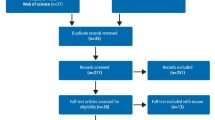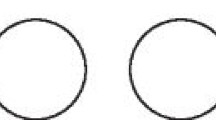Abstract
Data sources
Medline, CENTRAL and Embase and the reference lists of included articles
Study selection
Randomised controlled clinical trials (RCTs) or controlled clinical trials (CCTs) conducted in adults over 18 that compared CHX-V against placebo or control that reported root caries incidence and/or root caries activity were included. Only papers written in English were included.
Data extraction and synthesis
Study selection and data abstraction were carried out independently by two reviewers with disagreements resolved by discussion with third reviewer if required. Where appropriate, a meta-analysis was carried out using a ‘random effect’ model. As only a few studies could be included in the meta-analysis, data were also presented in a descriptive manner.
Results
Searches identified 32 papers with six meeting the inclusion criteria. Data extraction provided no conclusive evidence that the application of CHX-V is effective in patients when regular professional oral prophylaxis is performed. If effective, the 40% CHX-V was found to provide a benefit over a control or fluoride varnish. CHX-V at lower concentrations (1 and 10%) may provide protection against root caries in high-risk patients (such as geriatric and xerostomia patients) in the absence of regular professional oral prophylaxis.
Conclusions
Within the limitations of this review, it may be concluded that in the absence of regular professional tooth cleaning and oral hygiene instructions, CHX-V may provide a beneficial effect in patients in need of special care. The strength of this recommendation is graded as ‘weak’.
Similar content being viewed by others
Commentary
It has been proposed that CHX-V, with its antibacterial properties can reduce caries risk1, through its effect on mutans streptococci 2 However, two earlier reviews3, 4 of the effectiveness of CHX-V on caries in children and adolescents have proved inconclusive, as has a review by Twetman 5 for arresting root caries in elderly patients with xerostomia. There is an increased risk of root caries as people increasingly retain their teeth through their life course,6 and therefore a need to find ways of effectively preventing root surface caries within this growing cohort. This systematic review is therefore timely.
The review's question could perhaps have been slightly better focused, PICO style,7 to enable readers to understand exactly which population, intervention, comparison and outcome were being reviewed. As Cochrane recommends, a systematic review should identify all relevant studies from a number of different sources.8 A clear, pre-determined strategy was used to determine inclusion of randomised controlled trials, with independent assessment by two assessors. Slot searched a number of important databases, and included follow up of the reference lists from all selected studies, but did not include searches of grey literature, unpublished studies (e.g. clinical trials databases) or non-English-language databases (e.g. Lilacs, the Latin-American and Caribbean database.) Such exclusions would both reduce the overall papers reviewed, and increase the risk of publication bias. As noted by Egger9 authors are more likely to report positive results in an international journal, and more likely to report negative results in a local non English publication.
The authors give both quality parameters (internal and external validity, statistical methods) and a score to each of the reviewed papers. The individual rating of each domain is admirable as it allows readers to easily judge for themselves the quality of each paper under each specific feature of the study. Scoring systems such as the CEBM or Jadad scales, yielding a summary score, are however not recommended by Cochrane due to the inherent bias in calculating such a score.8
Within the reviewed papers there was a lack of comprehensive information as suggested by the CONSORT statement (www.consort-statement.org). There was no information given on the baseline and end point data for root caries activity, and no consistent measurement of DMF-RS. Characteristics of the patients (e.g. age) were either omitted or not comparable across papers, making it difficult to generalise the specific results. It may have been possible to retrieve this information through contact with the authors, but this does not seem to have occurred. Within the selected papers there was considerable heterogeneity, with variation in CHX-V concentrations, inclusion/exclusion criteria, the comparison group (control, fluoride varnish) and application regime (including cleaning regimes). There were also different methods used to measure both caries indices and activities. Such heterogeneity meant that only three papers were included in the meta-analysis. With the information provided it is difficult for the reader to determine whether the papers were similar enough to perform a meta-analysis. One way of overcoming this uncertainty would have been to include a forrest plot to provide a graphic illustration of the variation between studies. Within a Cochrane systematic review it is customary, within a meta-analysis, to use a form of weighted average, where some of the studies (depending on their size, level of bias etc) contribute more to the total than others. Slot's meta-analysis calculated weighted mean differences using Cochrane's Review Manager; it would however have been useful to have an explanation as to how the weighting was constructed.
The results were well presented with both descriptive and individual data. The results were presented as means +/- standard deviations. As Petrie10 suggests, the use of +/- should be avoided in data presentation, with the use of confidence intervals a preferred format for this display. The overall reduction of 0.65 in DMF-RS calculated through the meta-analysis had a reasonably wide confidence interval indicating the uncertainty of the analysis. As well as using systems to select and review individual papers, the authors also used the systematic scoring system GRADE 11 based on the trial type quality to assess the quality of this review as ‘weak’. The scoring system within this paper was not shown as part of this review.
In the conclusion it states that for special care patients in the absence of regular toothbrushing and oral hygiene instructions, CHX-V may provide a beneficial effect. While the evidence presented is suggestive of a greater effect in this group of patients, the quality of the evidence does not seem sufficient to make this a firm recommendation.
Practice points
-
There is currently only weak evidence of a positive effect of CHX-V on root caries and further high quality studies are necessary to confirm effectiveness.
References
Emilson CG . Potential efficacy of chlorhexidine against mutans streptococci and human dental caries. J Dent Res 1994; 73: 682–691.
Ribeiro LG, Hashizume LN, Maltz M . The effect of different formulations of chlorhexidine in reducing levels of mutans streptococci in the oral cavity: a systematic review of the literature. J Dent 2007; 35: 359–370.
Zhang Q, van Palenstein Helderman WH, van't Hof MA, Truin GJ . Chlorhexidine varnish for preventing dental caries in children, adolescents and young adults: a systematic review. Eur J Oral Sci 2006; 114: 449–455.
James P, Parnell C, Whelton H . The caries-preventive effect of chlorhexidine varnish in children and adolescents: a systematic review. Caries Res 2010; 44: 333–340. Epub 2010 Jul 7.
Twetman S . Antimicrobials in future caries control? A review with special reference to chlorhexidine treatment. Caries Res 2004; 38: 223–229.
Thomson WM . Dental caries experience in older people over time: what can the larger cohort studies tell us? Br Dent J 2004; 196: 89–92.
Miller SA, Forrest J L . Enhancing your practice through evidence-based decision making: PICO, learning how to ask good questions. J Evid Based Dent Pract 2001; 1: 136–141.
Higgins JPT, Green S (editors). Cochrane Handbook for Systematic Reviews of Interventions Version 5.1.0 [updated March 2011]. The Cochrane Collaboration, 2011. Available from www.cochrane-handbook.org. [Accessed June 5 2011]
Egger M, Zellweger-Zähner T, Schneider M, Junker C, Lengeler C, Antes G . Language bias in randomised controlled trials published in English and German. Lancet 1997; 350(9074): 326–329.
Petrie A, Sabin C . Medical statistics at a glance. 2nd ed. Blackwell Publishing, 2005.
Guyatt GH, Oxman AD, Schunemann AB, Tugwell P, Knottnerus A . GRADE guidelines: a new series of articles in the Journal of Clinical Epidemiology. J Clin Epidemiol 2011; 64: 380–382.
Author information
Authors and Affiliations
Additional information
Address for correspondence: Dagmar Else Slot, Department of Periodontology, Academic Centre for Dentistry Amsterdam (ACTA),University of Amsterdam and VU University Amsterdam, Gustav Mahlerlaan 3004,NL–1081 LA Amsterdam (The Netherlands). E-mail: d.slot@acta.nl
Slot DE, Vaandrager NC, Van Loveren C, Van Palenstein, Helderman WH, Van der Weijden GA. The effect of chlorhexidine varnish on root caries: a systematic review. Caries Res 2011; 45: 162–173.
Rights and permissions
About this article
Cite this article
Duane, B. Limited evidence of the effect of chlorhexidine varnish (CHX-V) on root caries. Evid Based Dent 12, 39–40 (2011). https://doi.org/10.1038/sj.ebd.6400787
Published:
Issue Date:
DOI: https://doi.org/10.1038/sj.ebd.6400787
This article is cited by
-
Prevention of root caries
Evidence-Based Dentistry (2011)



